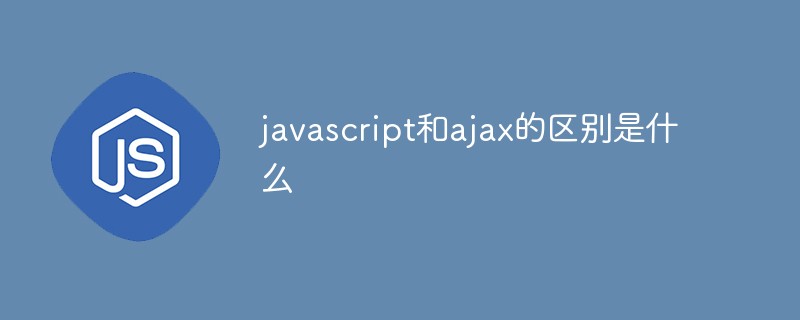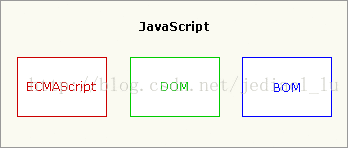What is the difference between javascript and ajax
Difference: JavaScript is a scripting language executed on the browser side, Ajax is a development technology for creating interactive web applications; JavaScript is used to add a variety of dynamic functions to web pages; and Ajax Provides an asynchronous update mechanism to achieve partial page updates.

The operating environment of this tutorial: windows7 system, javascript version 1.8.5, Dell G3 computer.
The difference between javascript and ajax
Javascript is a scripting language that is executed on the browser side, and Ajax is a way to create interactive web pages Application development technology uses a series of related technologies, including JavaScript.
JavaScript is a high-level scripting language that belongs to the Internet. It has been widely used in Web application development. It is often used to add various dynamic functions to web pages and provide users with smoother and more beautiful browsing effects.
Ajax provides an asynchronous update mechanism, which uses data exchange between the client and the server instead of the entire page document to achieve partial page updates.
JavaScript
The abbreviation of javaScript is JS, a scripting language widely used in client-side Web development. It is often used to add dynamic functions to HTML web pages (the programs written by it can be embedded into HTML or XML pages and interpreted and executed directly in the browser).
Components:
Core (ECMAScript), Document Object Model (DOM), Browser Object Model, Referred to as BOM)
Nowadays, it is more and more widely used in Internet web page production. 
Javascript is short and concise, and is executed on the client machine, which greatly improves the browsing speed and interactive capabilities of web pages. At the same time, it is a simple programming language specifically tailored for making Web pages.
Ajax AJAX is "Asynchronous JavaScript and XML" (asynchronous JavaScript and XML). AJAX is not an abbreviation, but a noun created by Jesse James Gaiiett. It refers to a way to create interactive Web development technology for web applications.Composition:
Representation based on XHTML and CSS standards;Use Document Object Model Perform dynamic display and interaction;
- Use XML and XSLT for data interaction and operation;
- Use XML HttpRequest for asynchronous communication with the server;
- Bind everything using JavaScript.
- Description:
- Ajax combines Java technology, XML and JavaScript and other programming technologies, allowing developers to build Web based on Java technology Apply and break management using page reloads.
Ajax is a Web application development method that uses client-side scripts to exchange data with the Web server. In this way, the Web page can be dynamically updated without interrupting the interaction process and re-editing it. Using Ajax, users can create direct, highly available, richer, and more dynamic Web user interfaces that are close to local desktop applications
[Related recommendations:javascript learning tutorial
]
The above is the detailed content of What is the difference between javascript and ajax. For more information, please follow other related articles on the PHP Chinese website!

Hot AI Tools

Undresser.AI Undress
AI-powered app for creating realistic nude photos

AI Clothes Remover
Online AI tool for removing clothes from photos.

Undress AI Tool
Undress images for free

Clothoff.io
AI clothes remover

Video Face Swap
Swap faces in any video effortlessly with our completely free AI face swap tool!

Hot Article

Hot Tools

Notepad++7.3.1
Easy-to-use and free code editor

SublimeText3 Chinese version
Chinese version, very easy to use

Zend Studio 13.0.1
Powerful PHP integrated development environment

Dreamweaver CS6
Visual web development tools

SublimeText3 Mac version
God-level code editing software (SublimeText3)

Hot Topics
 How to solve the 403 error encountered by jQuery AJAX request
Feb 20, 2024 am 10:07 AM
How to solve the 403 error encountered by jQuery AJAX request
Feb 20, 2024 am 10:07 AM
Title: Methods and code examples to resolve 403 errors in jQuery AJAX requests. The 403 error refers to a request that the server prohibits access to a resource. This error usually occurs because the request lacks permissions or is rejected by the server. When making jQueryAJAX requests, you sometimes encounter this situation. This article will introduce how to solve this problem and provide code examples. Solution: Check permissions: First ensure that the requested URL address is correct and verify that you have sufficient permissions to access the resource.
 PHP and Ajax: Building an autocomplete suggestion engine
Jun 02, 2024 pm 08:39 PM
PHP and Ajax: Building an autocomplete suggestion engine
Jun 02, 2024 pm 08:39 PM
Build an autocomplete suggestion engine using PHP and Ajax: Server-side script: handles Ajax requests and returns suggestions (autocomplete.php). Client script: Send Ajax request and display suggestions (autocomplete.js). Practical case: Include script in HTML page and specify search-input element identifier.
 How to solve jQuery AJAX request 403 error
Feb 19, 2024 pm 05:55 PM
How to solve jQuery AJAX request 403 error
Feb 19, 2024 pm 05:55 PM
jQuery is a popular JavaScript library used to simplify client-side development. AJAX is a technology that sends asynchronous requests and interacts with the server without reloading the entire web page. However, when using jQuery to make AJAX requests, you sometimes encounter 403 errors. 403 errors are usually server-denied access errors, possibly due to security policy or permission issues. In this article, we will discuss how to resolve jQueryAJAX request encountering 403 error
 How to solve the problem of jQuery AJAX error 403?
Feb 23, 2024 pm 04:27 PM
How to solve the problem of jQuery AJAX error 403?
Feb 23, 2024 pm 04:27 PM
How to solve the problem of jQueryAJAX error 403? When developing web applications, jQuery is often used to send asynchronous requests. However, sometimes you may encounter error code 403 when using jQueryAJAX, indicating that access is forbidden by the server. This is usually caused by server-side security settings, but there are ways to work around it. This article will introduce how to solve the problem of jQueryAJAX error 403 and provide specific code examples. 1. to make
 How to get variables from PHP method using Ajax?
Mar 09, 2024 pm 05:36 PM
How to get variables from PHP method using Ajax?
Mar 09, 2024 pm 05:36 PM
Using Ajax to obtain variables from PHP methods is a common scenario in web development. Through Ajax, the page can be dynamically obtained without refreshing the data. In this article, we will introduce how to use Ajax to get variables from PHP methods, and provide specific code examples. First, we need to write a PHP file to handle the Ajax request and return the required variables. Here is sample code for a simple PHP file getData.php:
 PHP vs. Ajax: Solutions for creating dynamically loaded content
Jun 06, 2024 pm 01:12 PM
PHP vs. Ajax: Solutions for creating dynamically loaded content
Jun 06, 2024 pm 01:12 PM
Ajax (Asynchronous JavaScript and XML) allows adding dynamic content without reloading the page. Using PHP and Ajax, you can dynamically load a product list: HTML creates a page with a container element, and the Ajax request adds the data to that element after loading it. JavaScript uses Ajax to send a request to the server through XMLHttpRequest to obtain product data in JSON format from the server. PHP uses MySQL to query product data from the database and encode it into JSON format. JavaScript parses the JSON data and displays it in the page container. Clicking the button triggers an Ajax request to load the product list.
 PHP and Ajax: Ways to Improve Ajax Security
Jun 01, 2024 am 09:34 AM
PHP and Ajax: Ways to Improve Ajax Security
Jun 01, 2024 am 09:34 AM
In order to improve Ajax security, there are several methods: CSRF protection: generate a token and send it to the client, add it to the server side in the request for verification. XSS protection: Use htmlspecialchars() to filter input to prevent malicious script injection. Content-Security-Policy header: Restrict the loading of malicious resources and specify the sources from which scripts and style sheets are allowed to be loaded. Validate server-side input: Validate input received from Ajax requests to prevent attackers from exploiting input vulnerabilities. Use secure Ajax libraries: Take advantage of automatic CSRF protection modules provided by libraries such as jQuery.
 Asynchronous data exchange using Ajax functions
Jan 26, 2024 am 09:41 AM
Asynchronous data exchange using Ajax functions
Jan 26, 2024 am 09:41 AM
How to use Ajax functions to achieve asynchronous data interaction With the development of the Internet and Web technology, data interaction between the front end and the back end has become very important. Traditional data interaction methods, such as page refresh and form submission, can no longer meet user needs. Ajax (Asynchronous JavaScript and XML) has become an important tool for asynchronous data interaction. Ajax enables the web to use JavaScript and the XMLHttpRequest object






